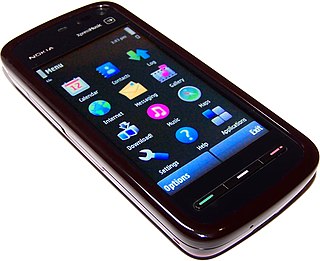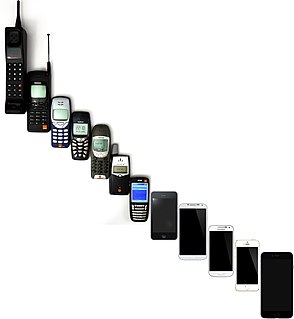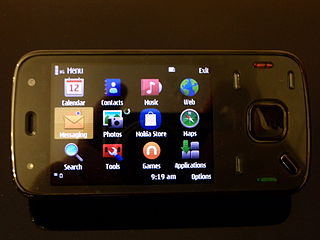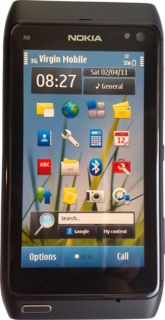Related Research Articles
DVB-H is one of three prevalent mobile TV formats. It is a technical specification for bringing broadcast services to mobile handsets. DVB-H was formally adopted as ETSI standard EN 302 304 in November 2004. The DVB-H specification can be downloaded from the official DVB-H website. From March 2008, DVB-H is officially endorsed by the European Union as the "preferred technology for terrestrial mobile broadcasting". The major competitors of this technology are Qualcomm's MediaFLO system, the 3G cellular system based MBMS mobile-TV standard, and the ATSC-M/H format in the U.S. DVB-SH now and DVB-NGH in the future are possible enhancements to DVB-H, providing improved spectral efficiency and better modulation flexibility. DVB-H has been a commercial failure, and the service is no longer on-air. Ukraine was the last country with a nationwide broadcast in DVB-H.
Series 40, often shortened as S40, is a software platform and application user interface (UI) software on Nokia's broad range of mid-tier feature phones, as well as on some of the Vertu line of luxury phones. It was one of the world's most widely used mobile phone platforms and found in hundreds of millions of devices. Nokia announced on 25 January 2012 that the company has sold over 1.5 billion Series 40 devices. It was not used for smartphones, with Nokia turning first to Symbian, then in 2012–2017 to Windows Phone, and most recently Android. However, in 2012 and 2013, several Series 40 phones from the Asha line, such as the 308, 309 and 311, were advertised as "smartphones" although they do not actually support smartphone features like multitasking or a fully fledged HTML browser.

The Nokia 7710 is a smartphone developed by Nokia and announced on 2 November 2004. It was the first Nokia device with a touchscreen, and first Nokia branded device with 2:1 aspect ratio display. The 7710 is based on the Nokia 7700 which was never released. It is Nokia's only smartphone to run the Series 90 interface atop Symbian OS v7.0s.
The Nokia N92 is a smartphone part of the multimedia Nseries. It was announced on November 2, 2005 and was the world's first mobile phone with an integrated DVB-H tuner. As a result, Nokia marketed it as a phone for watching TV on the go. It featured the same swivel design as the N90. It runs on Symbian OS v9.1 and the S60 3rd Edition interface.

XpressMusic was a brand name for a line of Nokia mobile phones that were specially designed for music playback. All of the XpressMusic handsets came with expandable MicroSD memory slots and dedicated music keys, so these phones could also be used as MP3 players. The XpressMusic range was launched in September 2006 to compete with the Walkman brand series from Sony Ericsson. Except from one device, all XpressMusic models were applied to the 5000 series models.

The Nokia 7700 is a smartphone produced by Nokia, announced in October 2003 but never released. It was produced as a prototype unit between 2003-2004. It was expected to be the first smartphone running the Series 90 GUI on Symbian OS and Nokia's first pen-based device, intending to compete against handsets like Sony Ericsson P800. At announcement Nokia dubbed it a "media device."

The Nokia 5310 is an XpressMusic mobile phone, introduced by Nokia on 29 August 2007 and released in the fourth quarter of 2007. It is less than a centimeter thick and is available with blue, red, purple, pink, orange, silver or black trim, the main body also being available in grey, black or white. It features many music specific features as well as a 2.0-megapixel camera. At 9.9 mm thick, it is one of few mobile phones measuring less than 1 cm thick at the time. It is one of the lightest phones Nokia has ever produced at 71 g.

The Nokia 5610 is a slider mobile phone from Nokia part of the XpressMusic series. Introduced August 2007 and launched in December, it runs on the Series 40 platform. The 5610's design is similar to that of the Nokia 5310 XpressMusic, with aluminium brushed sides and bold side colours of either red, blue, white, or pink. Above the regular D-pad with music buttons, the 5610 features a "sliding switch" below the display for navigation.

Nokia 5800 XpressMusic is a smartphone part of the XpressMusic line, announced by Nokia on 2 October 2008 in London and started shipping in November of that year. Code-named "Tube", it was the first touchscreen-equipped S60 device by Nokia - essentially it was the first device to run Symbian^1, also known as S60 5th Edition, the touch-specific S60-based platform created by the Symbian Foundation. The touchscreen features tactile feedback.

This is a comparison of the various internal components and features of many smartphones.

The Nokia N97 was a high-end smartphone introduced on 2 December 2008 by telecommunications manufacturer Nokia as part of its Nseries and released in June 2009 as the successor to the Nokia N96 phone. The N97 was Nokia's second S60-based touchscreen phone, after the Nokia 5800 XpressMusic. The device featured slide-out QWERTY keyboard, and ran on the Symbian v9.4 operating system. Its design took cues from the Nokia N79. A smaller 'mini' version was later released.

The Nokia N85 is a high-end smartphone produced by Nokia, announced on 27 August 2008 as part of the Nseries line. The N85 runs on Symbian OS v9.3 with S60 3rd Edition platform with Feature Pack 2. It was released in October, retailing for 450 euros before taxes.

The Nokia E75 is a smartphone from the Eseries range with a side sliding QWERTY keyboard and also front keypad.

The Nokia N86 8MP is a high-end smartphone announced on 17 February 2009 and released in May 2009. It runs on Symbian OS 9.3 and is part of the Nseries. It shares similar design features with the N97.

Nokia 5130 XpressMusic is a mobile phone manufactured by Nokia. It belongs to the XpressMusic series of phones, and runs on Nokia's Series 40 platform.

The Nokia X6 is a music-oriented capacitive touchscreen semi smartphone and portable entertainment device by Nokia. It was announced in early September 2009 during Nokia World 2009 in Germany.

The Nokia 5530 XpressMusic is a smartphone by Nokia announced on June 15, 2009. Part of the XpressMusic series of phones, it emphasizes music and multimedia playback. It is Nokia's third touchscreen phone based on the Symbian OS (S60) 5th edition platform.
Nokia 5330 Mobile TV Edition is a mobile phone from Nokia, announced on 16 November 2009. It features a DVB-H television receiver, and has been Nokia's only non-smartphone to do so. Its design is based on that of the Nokia 5330 XpressMusic, announced earlier in 2009.

The Nokia N8 is a touchscreen-based smartphone developed by Nokia. Announced on 27 April 2010, the Nokia N8 was the first device to run on the Symbian^3 mobile operating system and it was the company's flagship device for the year. It was released on 30 September 2010 at the Nokia Online Store before being released in markets around the world on 1 October 2010. There were two version made, the N8 and the N8-00. The N8 was made for Vodafone and locked to its networks, and the N8-00 was made by Microsoft and open network.
Nokia's strategic nomenclature can be traced back in 2005 when the Nseries line was launched, offering devices with flagship specifications and premium hardware at various price points. These devices were considered the "bread and butter" of the company and were often positioned to showcase their latest technologies. Thanks to the newfound consumer and enterprise interest in smartphones at the time, the company introduced four additional collections to diversify their product portfolio and meet demands in most market segments. These new phone series were named Eseries, targeting small business and enterprise customers; Xseries, providing consumer-grade multimedia-focused devices; Cseries, which Nokia used to target both the low-end and mid-range market segments; and Tseries, for devices exclusive to the Chinese market.
References
- ↑ Nokia SU-33W Product page Archived 2009-02-10 at the Wayback Machine